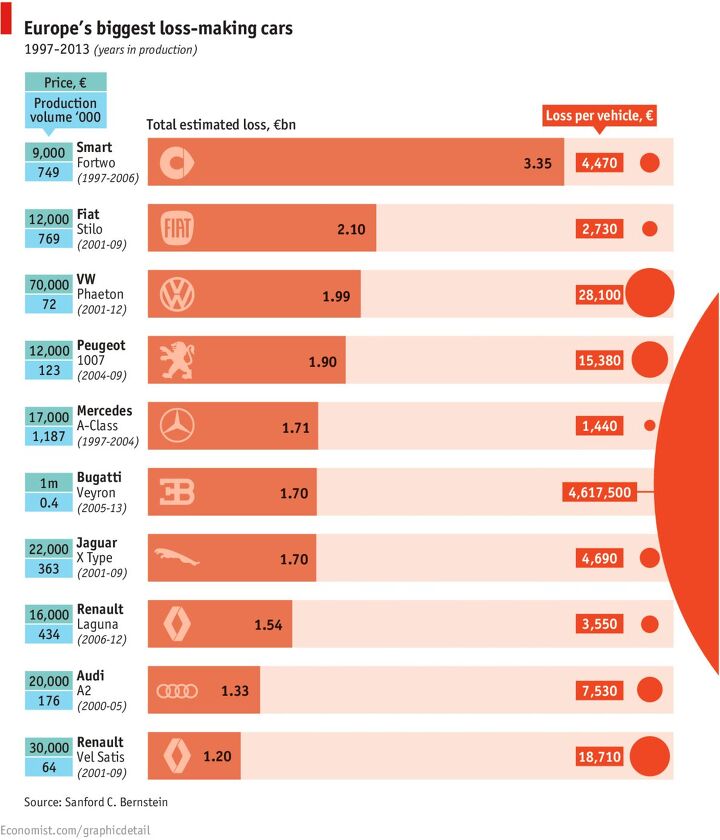The Europeans Show Ford & GM How Losing Money Is Really Done

Chart: Economist.com
Back in the 1950s, when Europe was still rebuilding after World War Two, Ford Motor Company and General Motors decided to show the world what a cost-no-object car was like in the American idiom. First Ford introduced the 1956 Continental Mark II, hand assembled down to the component level, that was said to lose $1,000 on each and every $10,000 Mark II sold. Adjusting for inflation, that loss is the equivalent about $8,600 in 2013 money. A year later, GM started selling the Motorama influenced Eldorado Brougham, at an even steeper $13,074. Motor City lore has it that not only was the Eldo Brougham thousands more expensive than the Mark II, its loses exceeded those of the Mark II by thousands of dollars as well. Now the Sanford C. Bernstein brokerage has looked at how much money various European automakers have lost on particular cars since 1997.
VW takes the top spot with the Bugatti Veyron, which Bernstein says loses a breathtaking 4.6175 million euros per vehicle. Even discarding the Veyron as a special case, VW still would hold the top (or bottom) spot with our EIC pro tem’s beloved Volkswagen Phaeton, said to lose over 28,000 euros per car. The Veyron and Phaeton weren’t the only cars that were bigger financial flops, adjusted for inflation, than the Mark II and Eldorado Brougham were. Renault lost 18,710 euros for every one of the 64,000 Vel Satis pseudo-coupes they sold from 2001 to 2009 (no mention of its twin, the Avantime), and the Peugeot 1007 lost PSA 15,380 euros for each of the 123,000 units sold. Audi’s ahead-of-its-time aluminum A2 subcompact was an unsurprising addition to the list, while some of the other entrants, like the Jaguar X-Type and the Smart Fortwo, were just plain bad.

Ronnie Schreiber edits Cars In Depth, the original 3D car site.
More by Ronnie Schreiber


































Comments
Join the conversation
Just as with women/romance, not all that glitters is gold. Just as with women/romance, sometimes you marry for love rather than reason. It's a great thing when you have both.
No one has brought this up, but how can the X-type have lost money? I know it didn't sell like crazy, but there wasn't much bespoke on it in the first place. It's like losing money on the 4th gen Buick Regal. Did everyone involved with the X-type get fired?
A minor point but the Vel Satis had nothing in common with a coupe, nor could the Avantime (which was a coupe) be considered a twin - apart from sharing a badge and a couple of engines they were based off completely different platforms. One point being repeately made is correct, though - several sources of the time claimed that VW swallowed all the development costs in the Phaeton project to make the Bentley Continental GT and Flying Spur (without those) look good financially. Add the development costs there and they would need to have sold those completely unchanged close to peak volumes for near a century to recuperate the initial investment.
While the math must have been entertaining and the comparison somewhat interesting, it is, for the most part, irrelevant. Two cars from the 50's vs more modern offerings? The question that is not asked and the comparison not made is, did the big three not loose money on cars since then? I find that hard to believe considering the bankruptcies etc. Would it not have made more sense to pick a few products (both sides of the pond) from the 90's? At least the math would be less eye watering. The only true competitor "money is no object" in the European list was the Vyron. The rest were misunderstood or poorly thought out vehicles int the wrong market at the wrong time, something the big 3 were pretty good at too, mind you.